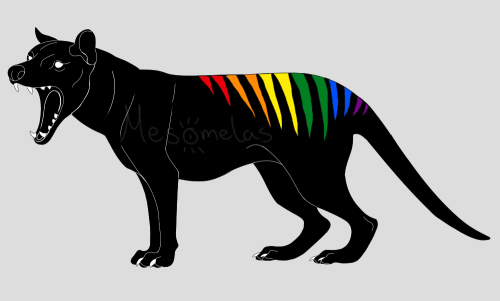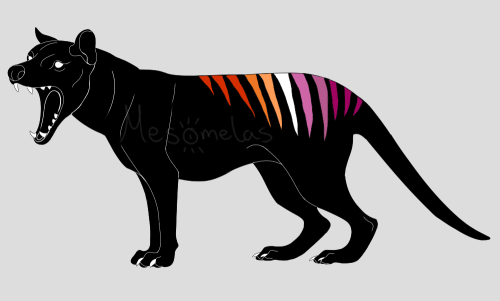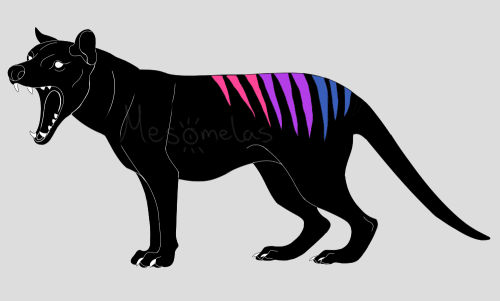Pridelacines Now Available On RedBubble! Show Your Stripes ❤








Pridelacines now available on RedBubble! Show your stripes ❤
More Posts from Jackasslope and Others

Jackalope: A North American cryptid that has been talked about since American colonial times. The real origin of this creature was a 1930s taxadermied hare with antlers grafted on. Since then, hundreds of similar mounts were created by several people, even into the 21st century. Due to the commonality of these mounts, many people were fooled into believing that jackalopes really existed. They aren’t cryptids in the same way that lake monsters are, but horned rabbits have existed in various cultures for centuries.
Daily painting 625

Inktober Day 12: The Ahuizotl
The ahuizotl is an amphibious creature, and when on land its fur dries into spikes as hard as steel. Its main prey is humans, although it only consumes the hair, fingernails, and teeth of its victims, leaving the rest of the body unscathed.


The Official Loch Ness Monster Sighting Register keeps a page on its website that highlights what does not make a Nessie sighting. The website uses actual accounts that have been reported to it to help decipher what shouldn’t be reported as a legitimate sighting. Some are the more common things that photographs or videos have been debunked as, such as boat wakes, seals, and floating logs. But some others include birds, divers, and even insects. The Register does explain itself on these. It says that the splashes from birds diving or taking off from the water can sometimes look like something suspicious. It explains a situation in 2015 where a woman reported a Nessie sighting but it was debunked as divers that were getting footage for Google Maps’ street view. As for the insects, the Register talks about how bugs too close to the camera lens can sometimes appear monster-ish.

The Last Thylacine: September 7, 1936
Hey everyone! This may be a little late depending on your time zone (as I’m in Los Angeles / PST, I’m behind practically everyone). Sorry about that!
Today, September 7th, 2019, marks the 83rd Anniversary of the death of the last known thylacine in the Hobart Zoo. This animal is pictured above.
There are a lot of myths and misconceptions surrounding the thylacine - and this individual in particular - so I thought I’d make a post to correct a few of these. Keep in mind that new facts and evidence do occasionally come to light, so this is of course subject to change!
MYTH #1: The last thylacine was named Benjamin.
FACT: The name “Benjamin” was allegedly given to the animal by a keeper named Frank Darby. Darby later claimed to have worked with this animal in an interview that took place in 1968. However, no record exists of Darby ever working at the Hobart Zoo, and the zoo curator’s daughter Alison Reid denied that Darby ever worked there.** [Source]
** Note: Although the nickname “Benjamin” was likely made up by Darby after the fact, it has stuck, so many thylacine enthusiasts (including me) still use it to refer to the last individual.
MYTH #2: The last thylacine was actually female.
FACT: Zoologist David Fleay, who took much of the film footage of this individual, stated in a newspaper article and diary entry that the animal was male, referring to it as a “fine male marsupial wolf.” Furthermore, in 2011, careful video analysis by Dr. Stephen Sleightholme (director of the ITSD) confirmed the presence of a scrotal sac, indicating that the last thylacine was indeed a male. [Source, Source]
MYTH #3: “Benjamin” was part of the Mullins family group.
FACT: The Mullins female was snared while her young were still in the pouch. This assertion would assume that “Benjamin” was one of the pups, grew up in captivity, and was the last surviving member of the family. However, in photos (including the one on this post), the snare mark is clearly visible on the animal’s hind leg, indicating that it was wild caught. It is more likely that “Benjamin” was snared by a man named Elias Churchill, though this is also debated. [Source]
MYTH #4: The carcass of “Benjamin” was immediately discarded after death because it was in poor condition.
FACT: The carcass was in fact sent to the Tasmanian Museum. What happened to it after that is unknown. [Source]



Pterosaurs have been sighted in the U.S., many of which occured during the Civil War. Sightings have occurred as recently as 2008 (as shown in the supposed pictures from above).
Although, many people claim pterodactyl/pterosaur sightings to be nothing but misidentifications of known birds such as the frigate bird.
-
 neptunefairytales liked this · 3 weeks ago
neptunefairytales liked this · 3 weeks ago -
 ladytisane liked this · 1 year ago
ladytisane liked this · 1 year ago -
 gaywarrren reblogged this · 1 year ago
gaywarrren reblogged this · 1 year ago -
 gaywarrren liked this · 1 year ago
gaywarrren liked this · 1 year ago -
 phoenixpinks reblogged this · 1 year ago
phoenixpinks reblogged this · 1 year ago -
 bonesfossilsrocksfur reblogged this · 1 year ago
bonesfossilsrocksfur reblogged this · 1 year ago -
 ammonitetheseaserpent reblogged this · 1 year ago
ammonitetheseaserpent reblogged this · 1 year ago -
 wyyyrm liked this · 1 year ago
wyyyrm liked this · 1 year ago -
 poobic liked this · 1 year ago
poobic liked this · 1 year ago -
 bones-n-bookles liked this · 1 year ago
bones-n-bookles liked this · 1 year ago -
 empress-cherazu liked this · 1 year ago
empress-cherazu liked this · 1 year ago -
 aydenburd liked this · 1 year ago
aydenburd liked this · 1 year ago -
 ozimul-reacts reblogged this · 1 year ago
ozimul-reacts reblogged this · 1 year ago -
 ozimulmakesartwork liked this · 1 year ago
ozimulmakesartwork liked this · 1 year ago -
 booboo-wheel reblogged this · 1 year ago
booboo-wheel reblogged this · 1 year ago -
 wizardimpersonator liked this · 1 year ago
wizardimpersonator liked this · 1 year ago -
 wizardimpersonator reblogged this · 1 year ago
wizardimpersonator reblogged this · 1 year ago -
 patchidusa liked this · 1 year ago
patchidusa liked this · 1 year ago -
 gravestoneangel liked this · 1 year ago
gravestoneangel liked this · 1 year ago -
 texastendy-29 liked this · 1 year ago
texastendy-29 liked this · 1 year ago -
 transguyswag666 liked this · 1 year ago
transguyswag666 liked this · 1 year ago -
 kamikuninuzuka reblogged this · 1 year ago
kamikuninuzuka reblogged this · 1 year ago -
 kamikuninuzuka liked this · 1 year ago
kamikuninuzuka liked this · 1 year ago -
 littlekingyami liked this · 1 year ago
littlekingyami liked this · 1 year ago -
 honeysucklebuttons liked this · 1 year ago
honeysucklebuttons liked this · 1 year ago -
 toripulu reblogged this · 1 year ago
toripulu reblogged this · 1 year ago -
 electro-strike reblogged this · 1 year ago
electro-strike reblogged this · 1 year ago -
 colubridkid liked this · 1 year ago
colubridkid liked this · 1 year ago -
 luciferapollyon reblogged this · 1 year ago
luciferapollyon reblogged this · 1 year ago -
 blackshuckpuppyboy reblogged this · 1 year ago
blackshuckpuppyboy reblogged this · 1 year ago -
 rooklinqs reblogged this · 1 year ago
rooklinqs reblogged this · 1 year ago -
 enby-opossums liked this · 1 year ago
enby-opossums liked this · 1 year ago -
 cosmiclattetigeress reblogged this · 1 year ago
cosmiclattetigeress reblogged this · 1 year ago -
 pondpossum liked this · 1 year ago
pondpossum liked this · 1 year ago -
 gaytoddanderson reblogged this · 1 year ago
gaytoddanderson reblogged this · 1 year ago -
 vitahlani liked this · 1 year ago
vitahlani liked this · 1 year ago -
 sparrowssonng reblogged this · 1 year ago
sparrowssonng reblogged this · 1 year ago -
 sparrowssonng liked this · 1 year ago
sparrowssonng liked this · 1 year ago -
 wulverarctos liked this · 1 year ago
wulverarctos liked this · 1 year ago -
 xthedragonrebornx reblogged this · 1 year ago
xthedragonrebornx reblogged this · 1 year ago -
 anakinfromaccounting liked this · 1 year ago
anakinfromaccounting liked this · 1 year ago -
 baronangsty liked this · 1 year ago
baronangsty liked this · 1 year ago -
 thecraftgremlin liked this · 1 year ago
thecraftgremlin liked this · 1 year ago -
 aaklige reblogged this · 1 year ago
aaklige reblogged this · 1 year ago -
 dilaughosaurus liked this · 1 year ago
dilaughosaurus liked this · 1 year ago -
 jespers-den reblogged this · 1 year ago
jespers-den reblogged this · 1 year ago -
 jespers-den liked this · 1 year ago
jespers-den liked this · 1 year ago -
 sydney-smith467 liked this · 1 year ago
sydney-smith467 liked this · 1 year ago











